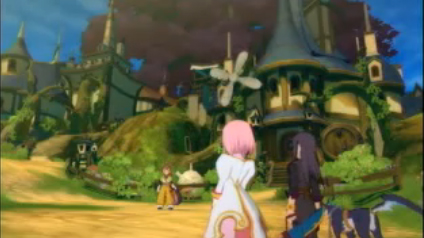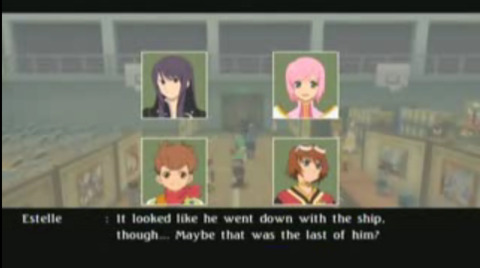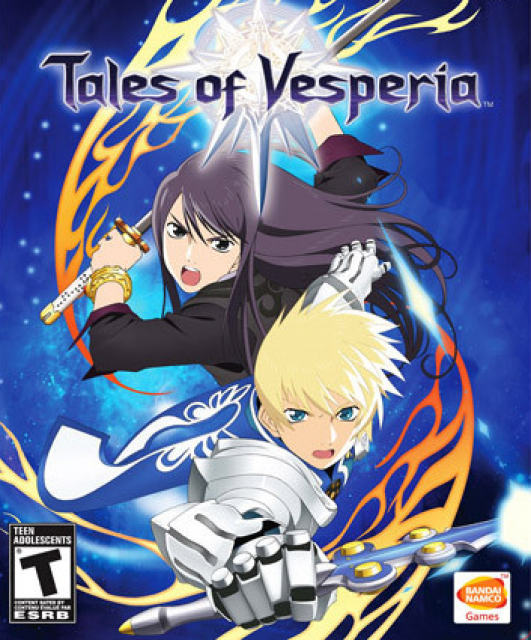A joy for fans of Tales as well as newcomers to the series

Do I need to play the other Tales games before Tales of Vesperia?
Nope. Vesperia is an entirely different world with an entirely different cast of characters from previous Tales. Really, the only thing linking the Tales games together is that all their names start with "Tales of..." and they have similar combat systems.XBox 360 or PS3 version?
As I am writing this, there is no PS3 version -- it's slated for release in Japan on September 17, 2009 (no word about a Western release), but it promises a lot of new content. Is it worth the wait? That really depends on how badly you want a new loli-pirate character, the ability to use Flynn in your party, new costumes (including ones of the characters from Tales of the Abyss), new dungeons, new spells, etc. Honestly, I'd say get the Xbox 360 version as it's at a relatively low price-point -- $30 and is more than worth every penny. If you find yourself wanting more after playing the original, purchase the PS3 one when it's released later -- I certainly am.
A quick run-down on the positives and the negatives!
Cheers
+ Excellent localization -- Good dialogue, funny jokes, voice acting that works well for the most part.+ Awesome cel-shaded art style -- Everything looks gorgeous.
+ Combat is a ton of fun -- Being able to switch who you control keeps it fresh and the AI is smart.
+ Fantastic character and creature design -- playable characters and NPCs look great and there are TONS of different types of enemies.
+ Great chemistry between the characters that the voice actors convey well, and just enough of a hint of romance that it really draws you in.
+ A skill system that lets you customize characters combat style and along with terrific itemization and crafting all go hand in hand well.
+ Old-school over-world map and exploration -- So few RPGs now have them and Tales does it really well with lots of little places to explore.
+ Plenty of costumes, accessories, and titles to earn.
+ Value - $30 for an 80+ hour game with tons of replayabilty, including an innovative New Game+ mode and a bonus dungeon.
Tears
- Definite sense of Deja Vu when liearning of the Final Boss's reasons for why he's doing what he's doing...- One or two of the voice actors does a few too many voices -- Not good when one of the main heroes voices one of the main bad guys...
- The ending leaves a lot to be desired.
- The English version of the opening song is as bad as it is infectious.
- The skits look really dated, like they belong in an SNES game.

Vesperia's story revolves around our hero, Yuri Lowell -- an ex-knight living in the impoverished Lower Quarters of the imperial capital. He's awoken to find that the area is flooding because of a Blastia (magical orbs that have various different powers) malfunction, or rather, the Blastia is missing entirely. Yuri decides to investigate the theft, which ends up landing him in jail. A suspicious man helps him out of prison and he makes his way from there, through the castle and comes upon a young girl fighting guards, begging them to let her leave.
Yuri steps in to help her then the two work their way out of the castle, but not before encountering some crazy man hellbent on killing Yuri's friend, Flynn; mistaking Yuri for his enemy. The pair make it out of the city with two goals -- Yuri wants find the missing Blastia and save the Lower Quarters while the young girl, Estelle, wants to find Flynn and warn him that he's in danger.

The overworld looks great and unlike older Tales games where many of the enemies just appeared as blobs, you can see exactly what mobs you'll be up against. It feels vast and expansive but becomes easy to navigate later in the game as more modes of transportation open up to you, so it never feels like a tedious journey. There are plenty of hidden places to explore and material nodes to find. All in all, they did a terrific job with the overworld and it's a shame that so many RPGs nowadays avoid having overworlds, or have strange unfinished versions such as in Lost Odyssey.
Cities range in detail from good to gorgeous, though most of them only have very small portions you can navigate (eg. two or three screens). While they feel small it makes it easy to navigate them and find the shops and quests. Dungeons and forests are similar in their size, feeling like bite-sized areas for the most part, though a few are large and expansive. Having smaller dungeons but more of them was a smart decision as it makes the plot feel like its constantly progressing and also presents you with a ton of different places to explore and different types of monsters to fight. You won't find yourself spending two hours in the same area wondering when the heck you'll reach the end of it, a problem endemic to many recent RPGs such as Star Ocean: The Last Hope.
The final dungeon and the bonus dungeon should please those who might find the regular dungeons too short and linear. The bonus dungeon, especially, is vast and time consuming, offering some recognizable characters from past Tales as bosses.
As mentioned, you are able to gather up multiple groups of mobs together and fight them all at once, which also helps clear areas out even faster. Considering that the combat system is so enjoyable, you'll find yourself going out of your way to do this to get more experience and grade points. Tales has continued to evolve its combat system and Vesperia's is similar to previous ones such as Tales of the Abyss or Symphonia in that you control one character while the others are AI-controlled. You can move them around the battle freely and bind different abilities to the different directions of both analogue sticks. On top of that you can access additional spells and abilities through your menu, as well as items, strategies, and the ability to change which character you control.
One thing that keeps the combat fresh and enjoyable is the ability to change which character you control on the fly (once you craft a particular item that allows you to do so, anyways). My first time through, I actually used Estelle as my main character 90% of the time (the other 10% using Yuri as that was the only option) and enjoyed playing as the healer while the AI went all out killing the enemies. It was great to see that the computer was competent at killing mobs, stopping to heal themselves when needed, or coming to my aid when I had mobs on me. On top of that, you can stop an AI controlled character from using an item if you'd rather they not use by hitting the left bumper., or set up very specific parameters of what they should do in combat via the main menu.
On top of this, your characters gain skills by equipping different weapons and armor and retain those skills after having worn the items through enough battles. These skills can range from more strength, to lower spell costs, to altering spells, to getting extra attacks or immunities. This gives you a lot of freedom on how you want certain characters to play. For example, you can give Estelle -- primarily a ranged healer -- skills that give her more attacks, strength, and better defenses, essentially making her a melee combatant. While not as powerful as someone like Yuri, she can still hold her own and is a lot of fun to control as such.
But wait, there's more! As your characters fight, they build up an Overdrive bar, and once it is full you can unleash it to put a character into a rush mode where they won't get knocked down from taking damage and their abilities can be linked over and over. This is especially devastating if you're using a caster, as their spells become instant, so you can unleash a torrent of damage on your hapless victims. It's especially fun to chain cast Meteor Strike with Rita over and over until the game hits 1 frame per second, as it has a hard time processing the insane number of meteors crashing into the ground. You can't really blame the game for hitting a snag when there's 40-50 huge boulders crashing into your enemies, exploding on impact.
Vesperia has a typical sized cast of usable characters -- seven on the 360 (with two more going to be available on the PS3). In combat you can only use four, but thankfully the ones outside combat can still gain experience and skill points -- more so if you equip them with relevant exp boosting skills. None of the fights ever feel like you need a certain setup (aside from maybe wanting to keep Estelle in your party for bosses as she's the only real "healer"), so you're free to use the characters who's aesthetics, fighting style, or personality appeals to you.
The characters are really what shines the most in Tales of Vesperia. Both playable characters and NPCs look like a lot of care went into their design and the localization team did a great job matching voices with characters in most cases. To get the bad out of the way -- every game has its share of annoying characters and Vesperia is no exception. The bumbling knights who keep trying to track Yuri down, and especially their pink armor clad superior are cringe-inducing at times and the voice acting just doesn't quite work for them. Speaking of that pink armor wearing noble, his English voice actor also voices one of the main heroes of the character. Something's just not right with using the same actor to voice both one of the heroes and one of the villains... could they not have grabbed a different voice actor? It doesn't help that he doesn't do a very good job of voicing the villain (though does a great job of voicing the good guy).
Aside from that small handful of characters, the rest are voiced really well. Yuri, Estelle, Rita, Duke, Judith, Raven, and Flynn are all perfectly cast -- it's hard to pick a favorite out of the bunch when they all do such a fantastic job. It also helps that the dialogue is generally well-writen and the relationships between the characters feel genuine and not forced. The relationship that develops between Yuri and Estelle will draw in even of the most casual romantic gamers, reaching a climax that pulls hard at the heartstrings.
Speaking of which, the game feels like it reaches its pinnacle around three quarters through the story. After that, there's still lots to do and plenty of loose ends to tie off, but the story begins to feel taken from previous Tales games and tacked on. It's not bad, but it's hard to compare with the impact of certain events that happen at that three quarters mark. I felt almost like I had finished the game and everything after that point was bonus content, even if it was still all part of the main story and credits hadn't rolled yet.
Aside from that, the only aspect of the story that felt weak was the skits though in a design capacity more than a plot capacity. After certain events you can hit the back button to trigger small conversations between your party members. These can range from discussing the recent story events further to just being silly rhetoric about eating too much or having a lot of gold. The dialogue itself is good and often humorous, but the portraits they use look like they belong in a SNES game and feel really dated. Considering how polished the art style of the rest of the game is, it's strange they neglected to update this aspect of the game -- especially when nearly all other JRPGs with conversations like this have beautifully drawn portraits, such as Disgaea, Ar Tonelico, or the Personas.

Something I failed to touch on until now is the amount of things to collect and craft. Each character gains titles based on things they do or plot points, with some titles giving them new costumes. There are also accessories you can equip your characters with that don't have stats but are cute little flavor items that add some uniqueness to each of the characters, such as Prince (from Katamari Damacy) doll for Yuri, or angel wings for Estelle. Collecting all of these things (as well as going for achievements, if that's your thing) add a ton of replayability to the game.
To make wanting to replay the game a much easier choice, the game offers a New Game + mode in which you're able to retain things by spending Grade Points you earned through your first play through. Not only spend points to keep items, levels, spells, etc. you can spend points to make the next play through easier. For example, you can spend points to unlock all of the maps, open up all the skits, or have mobs grant 10x more exp. This New Game + mode makes it very easy to want to play through the game a second time to find all the things you missed the first time through.

Tales of Vesperia is a BIG game and it's amazing how much stuff they crammed onto one DVD. With 80+ hours of content the first time through, endearing characters, a fun combat system, plenty of things like titles and costumes to collect, items to craft, skits to unlock, there's something for any fan of RPGs to enjoy. Considering the game can be found new for around $30 now, there's no reason not to get it if you're an RPG fan.
With so many RPGs coming out nowadays on multiple DVDs with less than half the content that Vesperia has to offer, it's hard to compare Vesperia to those other games. It goes so far above and beyond the norm that it stands in a higher class of games along with games like Persona 3, Final Fantasy X, or Xenogears.
If Namco-Bandai continues to build on their Tales series, improving on each new game, then we are in for some amazing Tales games in the future. As it stands, Vesperia is the best in a series of many great games and well worth a rating of five stars!
PS: "Blah blah blah!"

0 Comments